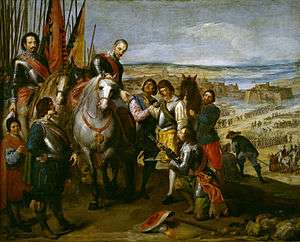Siege of Jülich (1621–22)
| Siege of Jülich | |||||||
|---|---|---|---|---|---|---|---|
| Part of the Eighty Years' War and the Thirty Years' War | |||||||
 The Surrender of Jülich circa 1635 by Jusepe Leonardo, oil on canvas. Museo del Prado. | |||||||
| |||||||
| Belligerents | |||||||
|
|
| ||||||
| Commanders and leaders | |||||||
|
|
| ||||||
| Casualties and losses | |||||||
| 3,000 surrendered[1] | unknown, minor | ||||||
The Siege of Jülich was a siege that took place between 5 September 1621 and 3 February 1622, during the Palatinate campaign of the Thirty Years' War. After five months of siege the Spanish army under Ambrosio Spinola took the Dutch-occupied fortress of Jülich, compelling its garrison to surrender.
Surrender and aftermath
The defenders, some 3,000 men, surrendered on 3 February, after five months of siege. Cardinal de la Cueva in Brussels had reported to the king that "han sentido mucho los olandeses la pérdida de Juliers" (the Dutch greatly regret the loss of Jülich).[1]
In line with her instructions to appoint Spaniards rather than Spanish Netherlanders as military governors of towns conquered from the Dutch, the Archduchess Isabella named Don Diego de Salcedo, reportedly a persona de muy buenas partes as governor of Jülich.[1]
Notes
References
- Irvine Israel, Jonathan (1997). Conflicts of empires: Spain, the Low Countries and the struggle for world supremacy, 1585-1713. Continuum International Publishing Group. ISBN 978-1-85285-161-3.
- Wilson, Peter H. (2009). The Thirty Years War: Europe's Tragedy. Harvard University Press. ISBN 978-0-674-03634-5.
Coordinates: 50°55′30″N 6°21′36″E / 50.925°N 6.360°E